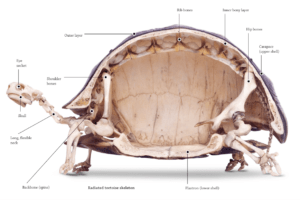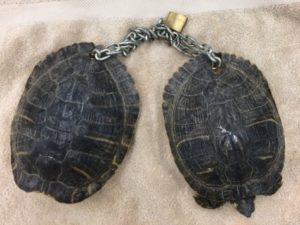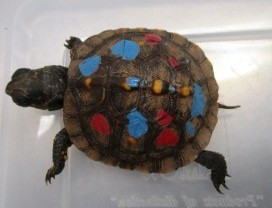A turtle’s shell is more than its home
By Samantha Kennett
CNC Wildlife Technician
A common myth regarding turtles is that they can leave their shell for another. However, this is not the case. Did you know that a turtle’s shell is a made of bone and is a part of the turtle’s spine? A turtle’s shell is as much a part of its body as our skeleton is to ours. The shell is made of two pieces, the carapace (top) and the plastron (bottom), which are fused together on each side at what’s called a bridge. The carapace is covered by an outer layer of individual pieces called scoots. These are made of keratin, just like your hair and nails. Who knew you had so much in common with our reptilian neighbors.

A turtle’s shell is its armor and its ultimate protection from many of the dangers of the world. But when that strong shell is cracked or broken, it leaves the turtle vulnerable to infection, bacteria, and predation by other animals. Though turtles are resilient, a severe injury to the shell could cost its life. Working as reptile rehabilitators, CNC’s Wildlife Rehabilitation Clinic receives countless injured turtles each year, many of which sustained injuries to their shells often the result of car collisions. CNC relies on a community of good Samaritans to transport these turtles to get them the appropriate care they need.
The reality of wildlife rehab is anything but warm and fuzzy. Fortunately for a couple red-eared sliders at CNC, a good Samaritan was walking the Roswell Boardwalk at just the right time. These turtles were found in the Chattahoochee River with punctured shells and chained together.

“Because the shell is living bone, any puncture can lead to systemic bacterial, viral, and/or fungal infections,” said Kathryn Dudeck, Wildlife Director at CNC. “Additionally, since the organs are not in a fixed position, but instead housed in a thin membrane called the coelom, the organs themselves can be damaged.”
A turtle’s shell is its greatest defense, but once compromised can be a potentially fatal weakness. With the help of the reptile vets at The Veterinary Clinic West in Marietta and the local good Samaritan who found them and brought them to CNC, these two turtles are on the road to recovery. This particular story will conclude with a happy ending, but that is not always the case.

Less obviously deadly is paint on the turtle’s shell. While it may look funny or cute to paint the shell, as we have learned, the shell is an integrated portion of the animal. They get their Vitamin D from the sun through their shells. The paint blocks this process and can be fatal to the animal.
“Turtles require UV light and specifically UVB wavelength for Vitamin D synthesis needed for bone and shell growth,” said Dudeck. “Unlike mammals and birds, reptiles cannot synthesize their own Vitamin D and must absorb sunlight through their shells. Painting the shell blocks the absorption of UV and can lead to weakened and deformed bones and shell.”
With paint, different removal techniques are used based on the type of paint, and the removal procedure can take several days.
With proper medications and care, a damaged shell can often grow back, though this can take months to years. If you see an injured turtle in the wild please call the Wildlife Clinic at the CNC at 770-992-2055 x239 or find your local rehabilitator at Animal Help Now.
